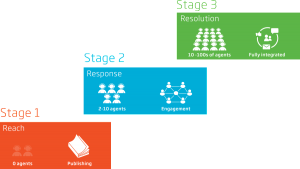Mobile apps are no longer an obsession. They became just an everyday utility to tackle everything from daily chores, satisfy information craves and shop the goods.
In 2015, 42% of all mobile sales made by the top 500 merchants took place in apps. Mobile traffic had already surpassed desktop traffic in USA, Japan and 8 other countries according to Google.
Online retailers can no longer afford to ignore mobile. In fact, mobile advertising is rapidly becoming an integral part of the overall marketing strategy and a standalone practice as well.
Yet, here rises the question of budgets.
Creating a branded mobile app for you company can set you back for as much as $ 50.000 to $ 150.000 – a number hardly affordable for small to mid-sized retailers. On top, promoting your new product and encouraging users to install yet another app to their device cuts another significant chunk from your budgets.
So, what alternatives ecommerce companies have?
Embrace Social Commerce

The term “social commerce” was first introduced by Yahoo! back in 2015 to describe all forms of user-generated content-sharing of online products and recommendations.
Today, social commerce practice stands for user-generated advertorial content on e-commerce websites and includes collaborative tools that users can use to get peer-to-peer advice, discover new goods and service, and make purchases. Social networks in this case serve as medium to spread this advice and leverage your brand’s trust factors based on social recognition.
In mobile age social commerce took another step further.
Take SavelGo – a new shopping app on the block, which blends together social shopping, local advertising and access to a mobile marketplace. As a retailer you can register a company profile, connect with your potential customers and gain a vaster exposure through the SmartFeed, which acts like a social network featuring news, visuals, custom offers and products based on the user’s previous shopping patterns. What you receive is a straight sales funnel based on the existing pool of avid shoppers without creating a branded app for your company.
Jifiti app offers another sort of exposure by allowing you to connect with your buyers through their gifting marketplace. You can register with the company to issue and sell your gift certificates that could be both used online and in-store.
Bottom line: If you are not ready to invest into a dedicated mobile app, get connected with social commerce companies to access the mobile pool of their users.
Make Your Emails Mobile Friendly
Mobile email opens now account for 15 to 70% depending on your industry, product and target audience. For ecommerce the number is estimated at 48.67%.
However, despite the number being that large, a lot of ecommerce companies continue ignoring mobile email optimization. Here are the key tips to improve your regular newsletters:
Optimize your subject line. Most mobile devices show just 25-30 characters in the subject line, whereas the standard desktop subject line is 60 characters long.
Use pre-header text – the opening line of your copy, displayed right under the subject and offering more insights about the content to your mobile users.
Keep it short and sweet. Mobile users won’t scroll all through your lengthy copy, no matter how enticing it may sound. Remember, your consumer is likely to be multitasking and to get your message heard you have to be concise and straight to the point. Make it easy to scan – headers, bullet points, short paragraphs and big clear CTA buttons.
Refrain from using too much visuals. Most mobile users have default “images off” settings, meaning an image-heavy email would look awkward.
Place the CTA at front and center. Grab the attention and urge the action immediately. For max clickability it’s best to use 44 x 44 pixels buttons.
Leave enough clicking space. Your mobile emails should have enough white space for easy scrolling and clicks, especially around CTAs.
Take Advantage of Location Targeting

According to a study by Search Engine Watch, 80% of local mobile searches convert into customers. For your business that means that mobile location tracking can significantly power up your marketing efforts.
You can toy around with location tracking in the next two ways:
Create custom campaigns with pop-up reminders that appear when users are close to your store or offering directions to the closest locations.
If your business doesn’t have a storefront, create location-specific discounts and special offers to pitch users in the targeted area.
If you are not yet into proximity marketing, it’s a high time to hop on the bandwagon.
Play The Mobile Speed Card
Mobile shopping usually inspires fast-track decision shopping and impulsive purchases (think Amazon one-click ordering), which can have both positive and negative impact on your business.
In case your mobile experience is not sub-par (some buttons are too small too tap) or the conversions rates are rather low, consider encouraging desktop retargeting.
This could be done by offering exclusive discounts to mobile shoppers, or any other special insensitive to encourage them to save the product for a later follow-up on their desktop.
Digital & Social Articles on Business 2 Community(53)







